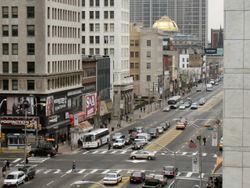NRHP Reference # 00001061 Designated NJRHP November 18, 1999 Added to NRHP 8 September 2000 | NJRHP # 126 Area 34 ha | |
 | ||
Architectural style Renaissance, Italianate, 19th and 20th-century eclectic Similar First National State Ban, Old First Presbyterian Church, National Newark Building, Home Office Building, Military Park | ||
Four Corners at the intersection of Broad and Market Streets in Newark, Essex County, New Jersey, United States, is the site of the city's earliest settlement and the heart of Downtown that at one time was considered the busiest intersection in the United States. A twenty-two-square-block area radiating from the crossroads is a state and federal historic district.
Contents
The crossing became the center of the town soon after establishment in 1666; the home of founder Robert Treat was located at the southwest corner. During the next centuries it remained the focal point of the city which grew around it. By 1834 the United New Jersey Railroad and Canal Company had established a terminal to the south and in 1869 the Newark and New York Railroad had one to the north. During the period of massive expansion at the start of the 20th century, the district became the city's modern business district, and site of its first skyscraper built by the Fireman's Insurance Company at the southeast corner in 1910. The Newark Public Service Terminal on Broad Street opened in 1916. Though faded in its former glory, the Four Corners district remains Newark's traditional center for commerce and business and since the late 2000s (decade) the focus of much interest in revitalizing retail, residential, and restaurant activity downtown.
Broad and Market
The names and the crossing of streets named Broad and Market is seen in many of the colonial cities in New Jersey, such as Paterson and Trenton and the United States, such as Philadelphia. In Newark, Broad Street, as the name suggests, is a wide avenue which runs north to Military Park and Broad Street Station, while to the south it passes Government Center and Symphony Hall. Market Street to the east passes Gateway Center and Newark Penn Station, while to the west are the Essex County Courthouse and the many university campuses located in the city. It has long been a busy crossroad. In 1915, Public Service counted over 280,000 pedestrian crossings in one thirteen-hour period. Eleven years later, on October 26, 1926, a State Motor Vehicle Department check at the Four Corners counted 2,644 trolleys, 4,098 buses, 2,657 taxis, 3,474 commercial vehicles, and 23,571 automobiles. Between 1925 and 1939 a manned 24-foot-tall (7.3 m) traffic control tower stood at the intersection.
Historic district
The historic district is one of seven in Newark. The Four Corners Historic District is roughly bounded by Raymond Boulevard, Mulberry Street, Hill, and Washington Streets and University Avenue. The district established in 1999–2000 encompasses an area of 85 acres (340,000 m2) and includes many buildings which themselves are listed on the national and state registers of historic places. The area is considered vital in the redevelopment of the city, located between city attractions, residential neighborhoods, educational and commercial institutions. In 2010, in order to promote the restoration of facades in the district the city has implemented stricter signage policy for any renovations.
The northwest quadrant of the district has been home to Prudential Headquarters since its founding. Three buildings built by the finance company, including the Gibraltar Building on Halsey Street, are found there, as is the original flagship store of the department store Bamberger's.
The city's two tallest buildings, the neoclassical National Newark and Art Deco Eleven 80, are found in the northeast quadrant near the abutting historic district of Military Park.
The southeast quadrant is home to the Kinney Building, Old First Presbyterian Church, the First National State Bank Building, the Newark and New York Railroad terminal, and Newark City Hall at Government Center. The Prudential Center borders this section at Mulberry Street. A new hotel and retail complex at Broad and Lafayette Streets is also planned. Several buildings in the southeast quadrant have been renovated for residential spaces
Teachers Village
In the southwest quadrant of the district some buildings, though more than 100 years old, are considered expendable in the greater development planning. To that end the demolition and replacement of some will lead to the creation of retail corridor between the Prudential Center and University Heights along Halsey Street. The four-block-long project will be designed by native son Richard Meier and called Teachers Village. Goldman Sachs committed $100million to the project.
Four Corners Millennium Project
In December 2012, the city council approved plans for further renovations in the district which would extend the neighborhood to Market Street that would rehabilitate former commercial buildings to residential and retail spaces. A similar proposal has been made for the former Newark Paramount movie palace. In January 2014, the Four Corners Millennium Project was awarded $52 million in New Jersey State Economic Development grants.
